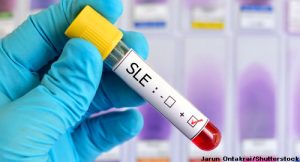 Autoantibodies that react with long interspersed nuclear elements (LINE-1) p40 protein may be common in severe and active systemic lupus erythematosus (SLE) patients, according to research from Victoria Carter, MS, and colleagues.1
Autoantibodies that react with long interspersed nuclear elements (LINE-1) p40 protein may be common in severe and active systemic lupus erythematosus (SLE) patients, according to research from Victoria Carter, MS, and colleagues.1
LINE-1, class I transposable elements in DNA, make up 17% of the human genome. Although most LINE-1 copies are mutated and truncated in the human genome, approximately 180 appear to be intact, with a few that continue to retrotranspose and occasionally disrupt genes or regulatory regions by novel insertions, according to the researchers. Because of this response, defense mechanisms have evolved against retro-elements and retroviruses. Some researchers theorize that many human diseases, including cancer and autoimmune diseases, are connected with LINE-1 biology, and several theories link LINE-1 to the development of SLE and its flares.
To help test this hypothesis, researchers used highly purified p40 proteins to quantitate immunoglobulin G autoantibodies found in the serum of 172 SLE patients, as well as disease controls (20 patients with systemic sclerosis) and age-matched healthy subjects (78 patients). The first cohort for the study included 10 patients with SLE. In a second SLE cohort, patients were in remission (n=83) or experiencing flare (n=79). The initial group of 10 patients came from the University of Washington Medical Center, Seattle, and the remaining patients were from Skåne University Hospital, Lund, Sweden.
In the majority of patients, as well as in many healthy controls, antibodies reactive with p40 proteins were detected. The results were higher in SLE patients, but not those with systemic sclerosis, when compared with healthy controls. Anti-p40 reactivity was higher during a flare among patients in remission (P=0.03). Anti-p40 reactivity also correlated with several other factors, including Systemic Lupus Erythematosus Disease Activity Index (SLEDAI) (P=0.0002), type I interferon score (P=006), complement C3 decrease (P=0.0001), anti-DNA antibodies (P<0.0001), anti-C1q antibodies (P=0.004) and a current or past history of nephritis (P=0.02). The antibodies were correlated inversely with age. In a study of SLE patient sera, the researchers also found a reaction with p40-associated proteins.
Within the SLE flare population, patients with high titers had higher SLEDAI scores than patients who were below the cutoff of the 90th percentile or more among healthy controls. Current anti-dsDNA antibodies and complement consumption also were associated with anti-p40 antibody levels. “Collectively, these data indicate that higher anti-p40 levels tend to accompany active disease,” the researchers write.
One finding that surprised researchers is a statistically higher inverse correlation of anti-p40 reactivity with SLE patient age (P<0.0001), which may be partially explained by the higher SLEDAI of younger patients, they write. However, even when the full cohort of SLE patients and healthy controls was split into two groups with an age cutoff at 40 years, researchers found a more marked association of anti-p40 reactivity with SLE in the younger group than in the total cohort.
LINE-1 may be a key trigger of SLE, working along with Ro60, La & other RNA binding proteins, according to Tomas Mustelin, MD, PhD.
Future Implications
“Clearly, anti-p40 antibodies do not by themselves herald clinically relevant autoimmunity, but more likely represent an early phase of self-reactivity that may—or may not—progress towards SLE. … Our findings that nearly all SLE patients have autoantibodies against the LINE-1 p40 protein and that these antibodies are associated with disease activity, specific disease manifestations, low complement, other autoantibodies and type I interferons, taken together, suggest that LINE-1 biology is coupled in some way to SLE pathogenesis,” the researchers write.

